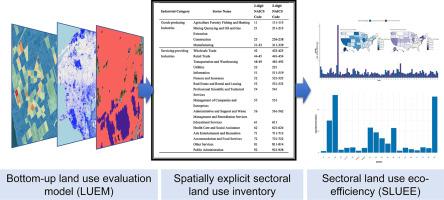A bottom-up nationwide analysis of sectoral land use reveals spatial heterogeneity across the United States
IF 11.2
1区 环境科学与生态学
Q1 ENGINEERING, ENVIRONMENTAL
引用次数: 0
Abstract
The high degree of urbanization and economic development in the United States has intensified competition for land resources, leading to land use conflicts and environmental challenges. Addressing these issues first requires an exploration of high-resolution, sector-specific land use patterns. However, existing land classification studies rarely provide spatially explicit data on urban land use across all sectors at a national level. This study aims to fill this gap by analyzing land use areas across various economic sectors in the United States, particularly focusing on urban impervious surfaces. Using a bottom-up approach, we created a full-sector land use inventory, integrating Points of Interest (POI) data, road networks, building characteristics, and geographic information processing techniques. Our primary innovation lies in the development of a spatially explicit database that details sector-specific land use areas nationwide. On this robust foundation, we further explored the heterogeneity of sectoral land use eco-efficiency (SLUEE) among different sectors and states, providing supplementary insights into spatial disparities in urban land use. Our findings reveal significant spatial heterogeneity, with service sectors dominating land use and exhibiting higher SLUEE compared to goods-producing industries. Key sectors such as Professional, Scientific, and Technical Services (441064.58 ha), and Administrative and Support Services (420148.34 ha) are prominent across states according to land use area, reflecting the country's service-oriented economy. Additionally, regional disparities in SLUEE are evident, with jurisdictions like Washington D.C., New York, and California demonstrating more efficient land use. Compared with traditional land use evaluations, our model effectively offers higher spatial resolution, down to the census block level, to sectoral land use evaluation. Building on this robust database, our SLUEE analysis has uncovered notable heterogeneity between sectors and states, offering new insights into cross-sectoral and inter-state land use dynamics that can inform and promote sustainable urban planning.

自下而上的全国范围部门土地利用分析揭示了美国各地的空间异质性
美国的高度城市化和经济发展加剧了对土地资源的争夺,导致了土地使用冲突和环境挑战。要解决这些问题,首先需要探索高分辨率、特定部门的土地利用模式。然而,现有的土地分类研究很少提供全国范围内各部门城市土地利用的明确空间数据。本研究旨在通过分析美国各经济部门的土地利用区域,特别是城市不透水表面来填补这一空白。我们采用自下而上的方法,整合兴趣点(POI)数据、道路网络、建筑特征和地理信息处理技术,创建了一份全行业土地利用清单。我们的主要创新在于开发了一个空间明确的数据库,详细记录了全国范围内特定部门的土地利用区域。在这一稳健的基础上,我们进一步探索了不同部门和州之间的部门土地利用生态效率(SLUEE)的异质性,为城市土地利用的空间差异提供了补充见解。我们的研究结果揭示了明显的空间异质性,与商品生产行业相比,服务行业在土地利用中占主导地位,并表现出更高的 SLUEE。根据土地使用面积,专业、科学和技术服务(441064.58 公顷)以及行政和支持服务(420148.34 公顷)等关键行业在各州都很突出,反映了该国以服务为导向的经济。此外,SLUEE 的地区差异也很明显,华盛顿特区、纽约和加利福尼亚等辖区的土地使用效率更高。与传统的土地利用评估相比,我们的模型有效地为部门土地利用评估提供了更高的空间分辨率,直至普查街区级别。在这一强大数据库的基础上,我们的 SLUEE 分析发现了部门和州之间的显著异质性,为跨部门和州之间的土地利用动态提供了新的见解,可为可持续城市规划提供信息并促进其发展。
本文章由计算机程序翻译,如有差异,请以英文原文为准。
求助全文
约1分钟内获得全文
求助全文
来源期刊

Resources Conservation and Recycling
环境科学-工程:环境
CiteScore
22.90
自引率
6.10%
发文量
625
审稿时长
23 days
期刊介绍:
The journal Resources, Conservation & Recycling welcomes contributions from research, which consider sustainable management and conservation of resources. The journal prioritizes understanding the transformation processes crucial for transitioning toward more sustainable production and consumption systems. It highlights technological, economic, institutional, and policy aspects related to specific resource management practices such as conservation, recycling, and resource substitution, as well as broader strategies like improving resource productivity and restructuring production and consumption patterns.
Contributions may address regional, national, or international scales and can range from individual resources or technologies to entire sectors or systems. Authors are encouraged to explore scientific and methodological issues alongside practical, environmental, and economic implications. However, manuscripts focusing solely on laboratory experiments without discussing their broader implications will not be considered for publication in the journal.
 求助内容:
求助内容: 应助结果提醒方式:
应助结果提醒方式:


